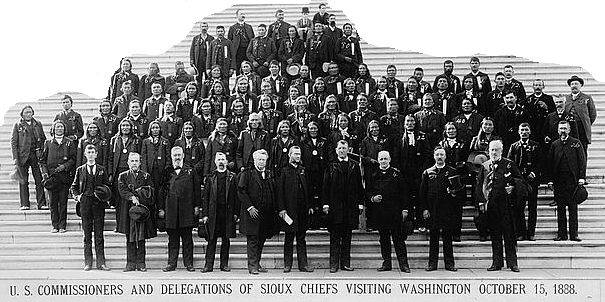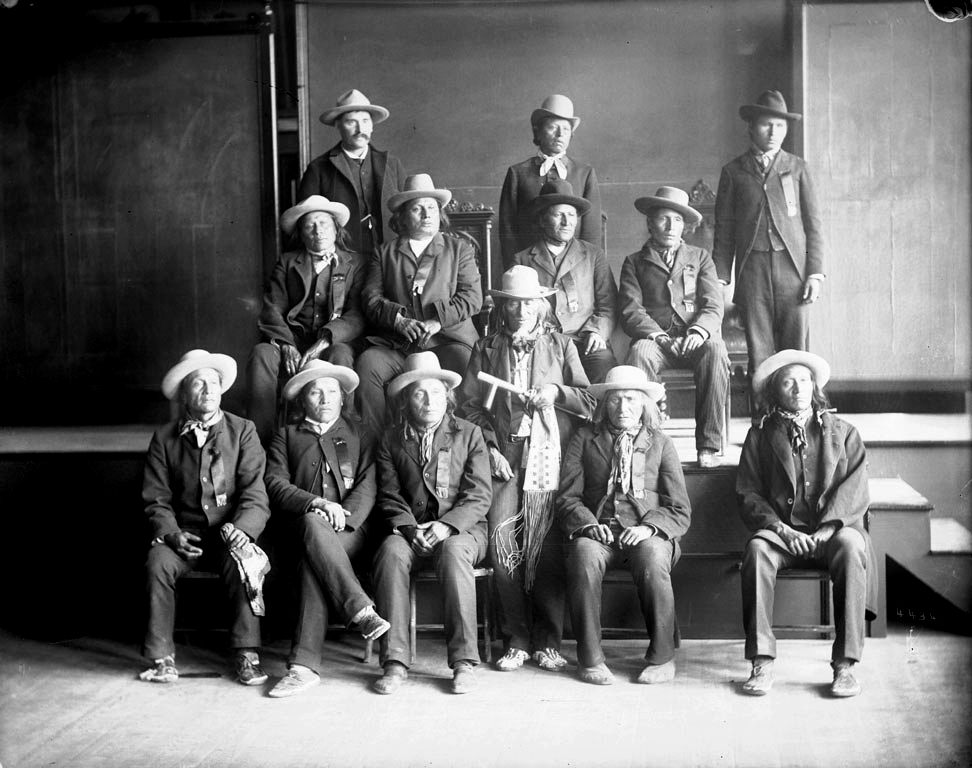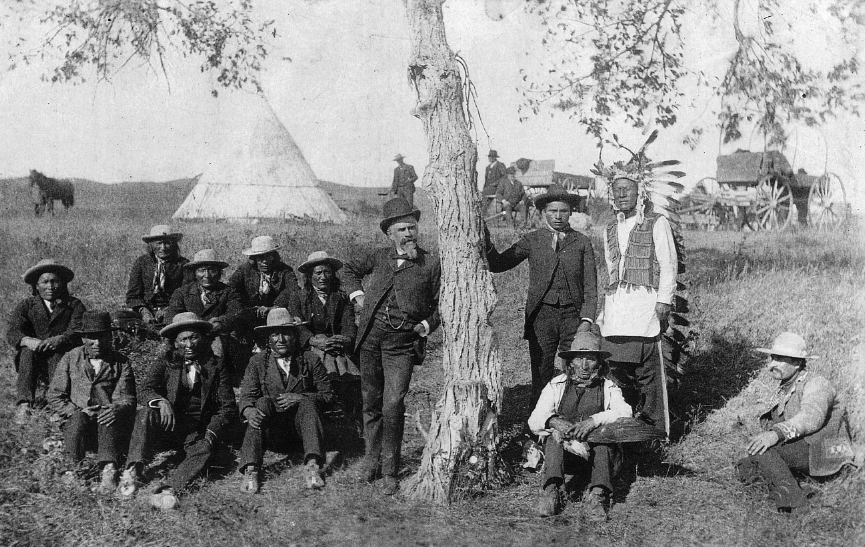|
Sioux Chiefs & US Commissioners : the photograph of the Sioux Commission of 1888 in Washington DC 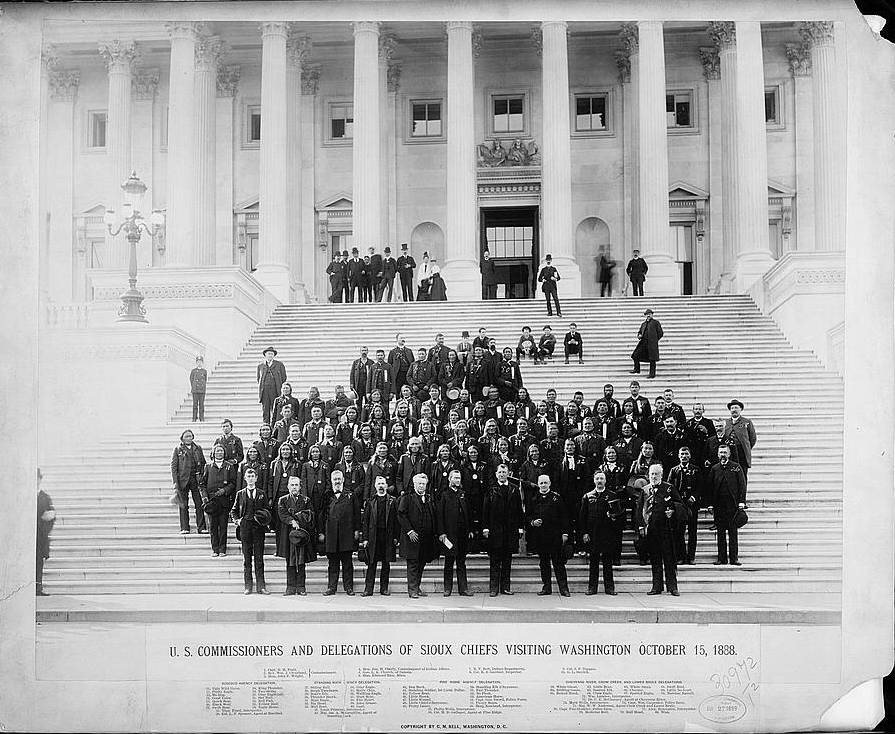 Photograph of "U.S. commissioners and delegations of Sioux chiefs visiting Washington, October 15, 1888." by CM Bell, US Library of Congress: CM Bell Collection, LC-USZ62-92959
US Government's purpose of the Sioux visit: to discuss implementation of the Dawes' General Allotment Act on the Great Sioux Reservation - the division, rationing and allotment of tribal lands to Sioux individuals, followed by sale of 'excess' lands to white settlers, in order to extinguish "communal [Indian] title to their land and for the dissolution of the tribal governments, with the object of making the tribes a constituent part of the United States"; and to "deplete[] the land base, [thus] ending hunting as a means of subsistence".
Location: Old U.S Capitol Building, East façade, now gone. Columns from the central portico of the East Front of the U.S. Capitol Building were removed when that area of the capitol was redesigned and extended between 1958 and 1962 and now compose the "Old U.S. Capitol Column Sculpture" of the United States National Arboretum in Washington DC, erected in 1988.
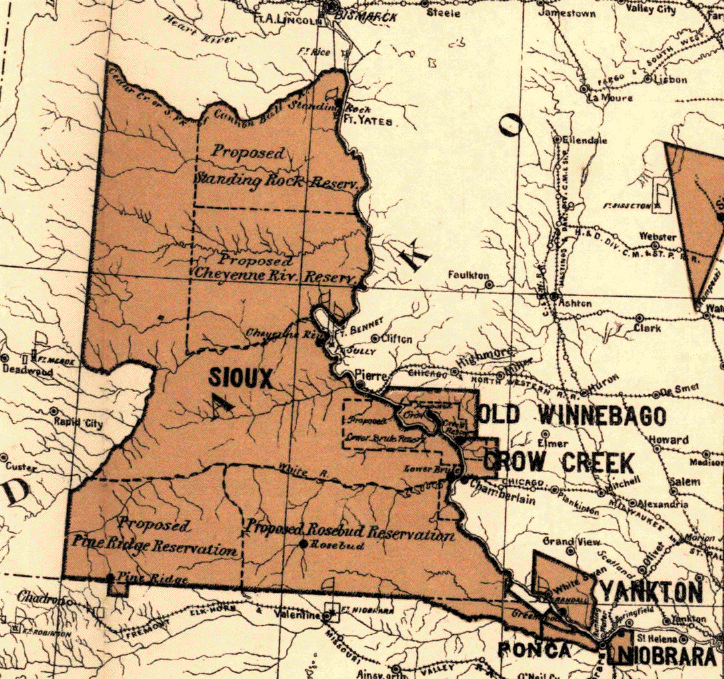 the Great Sioux Reservation in 1888 - map detail from 1888 Map showing the location of the Indian reservations within the limits of the United States and territories, compiled from official and other authentic sources, under the direction of the Hon. Jno. H. Oberly, Commissioner of Indian Affairs; Wm. H. Rowe, draughtsman: online at Oklahoma State University Libraries
1874 discovery of gold in the Black Hills 1878-1887 - "Great Dakota Boom"/ "Dakota fever" - American desire for Dakota land 1884 March - Dawes' Sioux Bill introduced 1887 General Allotment Act aka Dawes Act - allotment/privatizing of tribal lands policy 1888 April 30 - Dawes Sioux Bill, established a commission to negotiate the purchase of 11,000,000 acres of Sioux land at 50¢/acre 1888 July 21 - August 7 - US Commission chaired by Richard Henry Pratt ("the Pratt Commission") visited Standing Rock to promote the land sale; then visited Crow Creek and Lower Brule; did not visit Cheyenne River, Pine Ridge or Rosebud believing it to be futile. 1888 September 24 - council of Sioux chiefs from the six reservations at Lower Brule Reservation, called by Pratt 1888 October - council of Sioux chiefs from the six reservations at Washington DC, called by US Interior Secretary Vilas; offered price of Indian land to be $1/acre for three years, then 75¢/acre for two years, then 50¢/acre ever after. US Government sold its lands at $1.25/acre.
text transcription:
6th row from bottom (on right) 73, 74, 75 5th row from bottom (on right) 70, 71, 72 4th row from bottom (on right) 56, 57, 58 3rd row from bottom (on right) 42 2nd row from bottom (on right) 26 1st row (bottom) 10, 9, 8, 7, 3, 2, 1, 4, 5, 6
others 26. Col. L. F. Spencer, Agent at Rosebud Agency 42. Maj. James A. McLaughlin, Agent at Standing Rock Agency 58. Col. H. D. Gallager, Agent at Pine Ridge Agency 72. Dr. C. E. McChesney, Agent at Cheyenne River Agency 75. Maj. W. W Anderson, Agent at Crow Creek and Lower Brule Agencies 74. Capt. William Carpenter, Crow Creek Police Force
interpreters notes Capt. R. H. Pratt, founder and superintendent of the Indian School at Carlisle, Pennsylvania (later general, later removed from the school by presidential order, June 1904) Ft. Marion, this 30th day of September, 1876, from 1st. Lt. R.H. Pratt, 10th Cavalry, in charge of Indian Prisoners, U.S. Army / R.H. Pratt, 10th U.S. Cavalry, in charge of Indian Prisoners, Actg. Indian Agent. Indian POWs under 1st. Lt. R.H. Pratt, 10th Cavalry, June 1877 Prisoner of War-related Correspondence. Lt. R.H. Pratt, 10th Cavalry, in charge of Indian Prisoners, U.S. Army, ... R. H. Pratt to Adjt. General of the Army, Washington, D.C. Fort Marion, ... home.epix.net/~landis/prattletters.html
| ||||||||||||||||||||||||||||||||||||||||||||||||||||||||||||||||||||||
